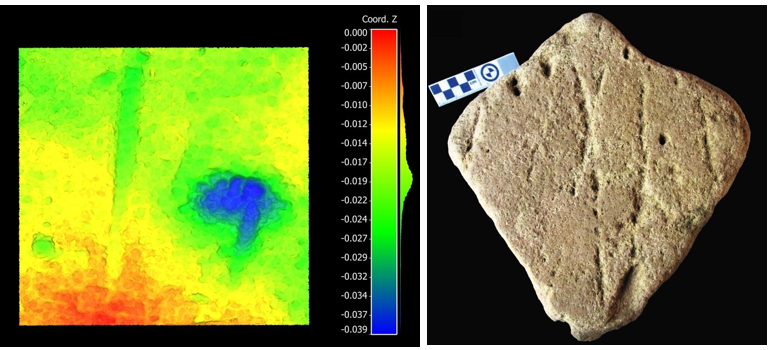One of the first things many kids (or adults) do when they are on a beach or dune is to make patterns in the sand, or sculptures (e.g. sand-castles).
Whereas many generations of humans have enjoyed such activity, until now there has been no reported evidence to suggest how far back in human history this may have occurred.
The Cape south coast of South Africa contains one of the richest Middle Stone Age archaeological records in the world, including some of the oldest known examples of rock engraving and rock painting, says Dr Charles Helm from Peace Region Paleontology Research Centre, British Columbia, Canada.
The rest of the team consists of African Centre for Coastal Palaeoscience’s Drs Jan de Vynck and Willo Stear; Dr Carina Helm from the Peace Region Paleontology Research Centre, British Columbia, Canada; Hayley Cawthra of the Marine Geoscience Unit, Council for Geoscience, South Africa and Renee Rust from the University of the Witwatersrand.
Evidence suggests that the area may have been critical to the survival of the human species. As many as 40 footprints made by hominins travelling down a dune surface, and estimated as being 90,000 years old, were identified here in 2016.
The research team asked the following questions: in addition to recording the fossil footprints of ancient humans, could those ancient dune and beach surfaces have recorded other evidence of human activity, such as patterns, symbols, sculptures, or evidence of foraging?
If so, could such ancient canvases of sand, now preserved as surfaces of coastal rocks, leave evidence that can be discerned and interpreted today? Indeed, could such evidence form a previously undocumented form of Middle Stone Age hominin expression and activity?
In a paper *Proceedings of the Geological Association, the team presents their interpretation of features of possible hominin origin at eight sites along the Cape south coast (two in the Garden Route National Park, near Sedgefield, five in the Goukamma Nature Reserve near Knysna, and one east of Still Bay).
The team’s findings include a large near-perfect circle (with a central depression that suggests how it may have been created), patterns of groove features beside possible human footprints, geometrical patterns, a ‘hashtag’ pattern, two possible animal images (one of which may have been a sculpture of a sting-ray), and possible trace fossil evidence of foraging.
The team proposed a new term to describe patterns drawn in sand, which becomes lithified over time through a natural cementation process: ammoglyph (‘ammos’ being Greek for ‘sand’, and ‘glyph’ being Greek for a carving, image or symbol).
There is a multitude of lines, grooves, patterns and shapes on these rock surfaces, and one of the team’s challenges lay in identifying whether a hominin ‘signature’ could reasonably be inferred.
They therefore reported on other possible agents that may have caused such patterns (e.g. wind, water, fossil roots and branches, and traces made by invertebrates, reptiles, birds and other mammals).
They also considered how to distinguish between ancient patterns made in sand and more recent patterns etched in rock (e.g. graffiti).
Samples have been taken for dating, adjacent to most of the sites they describe.
Based on previous dating studies obtained from rocks in this region, they anticipate that the results are likely to be within the range of 158,000 years to 70,000 years old.
The team concluded that evidence of a hominin presence on these ancient Pleistocene landscapes, already confirmed by footprints, is more substantial than has previously been appreciated.
*Proceedings of the Geological Association (2019) available online “in press” at https://doi.org/10.1016/j.pgeola.2019.08.004: Helm, C.W.; Cawthra, H.C.; De Vynck, J.C.; Helm, C.J.Z.; Rust, R.; Stear. W. Patterns in the Sand: A Pleistocene hominin signature along the South African coastline?

